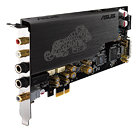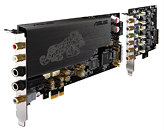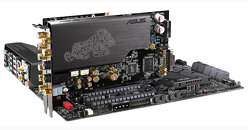Thursday, March 13th 2014

ASUS Announces the Essence STX II and Essence STX II 7.1 Sound Cards
ASUS today announced Essence STX II and Essence STX II 7.1, two new Hi-Fi-grade sound cards designed to delight audiophiles with 124 dB signal-to-noise-ratio (SNR) clarity and a 600 ohm-headphone amplifier.
Essence STX II and STX II 7.1 build on the success and huge popularity of ASUS Essence STX - the world's first consumer sound card to deliver 124 db SNR audio clarity plus 600 ohm headphone amp, and the long-term holder of the number-one position in Head-Fi's Sound Cards charts, as voted by highly-satisfied users globally.Keeping the audiophile spirit and philosophy alive, the new Essence STX II and STX II 7.1 cards both feature a remarkable 124 dB SNR for line-out connections and 120 dB SNR for headphone listening. Precision clock is controlled by a temperature-compensated crystal oscillator (TCXO) clock source, optimized power delivery is assured with low-dropout (LDO) regulators and WIMA capacitors deliver balanced sound.
With an amplifier capable of delivering impeccable output for up to 600 ohm headphones, an additional gain control for in-ear monitor (IEM) headphones, high-quality MUSES operational amplifiers (op-amps) and an included op-amp swap kit, ASUS once again demonstrates its ability to redefine the sound card market. Essence STX II 7.1 even has the ability to output true 7.1-channel surround sound, via the included simple-to-fit daughterboard.
Commenting on the launch, Ives Chiu, ASUS Product Manager for the Audio Sector in the Multimedia Business Department, said: "Four years after the debut of Essence STX, ASUS remains committed to delivering ever better high-end sound cards to delight the most demanding audiophiles. Drawing on years of experience in developing Essence One, Essence STU and Essence III, Essence STX II delivers meticulous design, quintessential performance and profound musicality - elements that shape the spirit of the whole Essence Hi-Fi series."
Legendary audio quality that just got better
Essence STX II and STX II 7.1 deliver industry-leading 124 dB SNR audio clarity, a much-envied quality inherited from the revolutionary and widely-acclaimed Essence STX sound card - and up to 64 times (64X) better than typical onboard audio hardware. Headphone output reaches a fantastic 120 dB.
To attain the essence of sound, ASUS engineers equipped Essence STX II and STX II 7.1 with even more Hi-Fi-quality components. These include a premium TCXO clock source that ensures ultra-low jitter, high-fidelity LDO regulators for consistent linear regulation and German-made WIMA capacitors for a more balanced sound. The profound musicality that Essence listeners expect is encapsulated by celebrated MUSES 8920 and MUSES 8820 op-amps, which deliver true-to-life tonality and spacious sound imaging.
Both Essence STX II and STX II 7.1 benefit from swappable op-amp sockets and come with a swap kit that includes three additional op-amps - two Texas Instruments LME49720s and one MUSES 8820 - that allow users to create different timbres and tonal combinations. The swap kit includes a clamp tool that makes it easy to remove the op-amp microchips.
True 7.1-channel surround sound that's easy to fit and great to customize
Exclusive to Essence STX II 7.1 is a multichannel daughterboard that delivers true 7.1-channel surround with high-fidelity 120 dB SNR outputs. This easy-to-fit daughter board slides into a slot adjacent to Essence STX II 7.1, so installation couldn't be more convenient.
Each channel is fully customizable with nine swappable op-amp sockets - giving audiophiles complete freedom to create the perfect surround-sound experience for their ears and listening environment.
Impeccable audio quality that's all about the details
In their mission to create peerless sound output ASUS audio engineers study and consider all aspects of product design - attention to detail that shines through both Essence STX II and STX II 7.1.
The built-in headphone amplifier supports up to 600 ohm impedance - so audiophiles can plug in the finest high-impedance headphones to enjoy the pure quality delivered by Essence STX II and STX II 7.1.
ASUS engineers have also furnished the new cards with an additional gain control designed especially for high-sensitivity IEM headphones, allowing musicians, audio purists and everyday listeners to use snug-fitting earpieces that channel audio output straight to the ear canal - isolating ambient noise for clear sound and undisturbed listening experience.
The cards also benefit from a software package that includes a full version of Dolby Home Theater, an advanced software suite that turns a PC into a dedicated home-theater center with enhanced surround sound.
Essence STX II and STX II 7.1 build on the success and huge popularity of ASUS Essence STX - the world's first consumer sound card to deliver 124 db SNR audio clarity plus 600 ohm headphone amp, and the long-term holder of the number-one position in Head-Fi's Sound Cards charts, as voted by highly-satisfied users globally.Keeping the audiophile spirit and philosophy alive, the new Essence STX II and STX II 7.1 cards both feature a remarkable 124 dB SNR for line-out connections and 120 dB SNR for headphone listening. Precision clock is controlled by a temperature-compensated crystal oscillator (TCXO) clock source, optimized power delivery is assured with low-dropout (LDO) regulators and WIMA capacitors deliver balanced sound.
With an amplifier capable of delivering impeccable output for up to 600 ohm headphones, an additional gain control for in-ear monitor (IEM) headphones, high-quality MUSES operational amplifiers (op-amps) and an included op-amp swap kit, ASUS once again demonstrates its ability to redefine the sound card market. Essence STX II 7.1 even has the ability to output true 7.1-channel surround sound, via the included simple-to-fit daughterboard.
Commenting on the launch, Ives Chiu, ASUS Product Manager for the Audio Sector in the Multimedia Business Department, said: "Four years after the debut of Essence STX, ASUS remains committed to delivering ever better high-end sound cards to delight the most demanding audiophiles. Drawing on years of experience in developing Essence One, Essence STU and Essence III, Essence STX II delivers meticulous design, quintessential performance and profound musicality - elements that shape the spirit of the whole Essence Hi-Fi series."
Legendary audio quality that just got better
Essence STX II and STX II 7.1 deliver industry-leading 124 dB SNR audio clarity, a much-envied quality inherited from the revolutionary and widely-acclaimed Essence STX sound card - and up to 64 times (64X) better than typical onboard audio hardware. Headphone output reaches a fantastic 120 dB.
To attain the essence of sound, ASUS engineers equipped Essence STX II and STX II 7.1 with even more Hi-Fi-quality components. These include a premium TCXO clock source that ensures ultra-low jitter, high-fidelity LDO regulators for consistent linear regulation and German-made WIMA capacitors for a more balanced sound. The profound musicality that Essence listeners expect is encapsulated by celebrated MUSES 8920 and MUSES 8820 op-amps, which deliver true-to-life tonality and spacious sound imaging.
Both Essence STX II and STX II 7.1 benefit from swappable op-amp sockets and come with a swap kit that includes three additional op-amps - two Texas Instruments LME49720s and one MUSES 8820 - that allow users to create different timbres and tonal combinations. The swap kit includes a clamp tool that makes it easy to remove the op-amp microchips.
True 7.1-channel surround sound that's easy to fit and great to customize
Exclusive to Essence STX II 7.1 is a multichannel daughterboard that delivers true 7.1-channel surround with high-fidelity 120 dB SNR outputs. This easy-to-fit daughter board slides into a slot adjacent to Essence STX II 7.1, so installation couldn't be more convenient.
Each channel is fully customizable with nine swappable op-amp sockets - giving audiophiles complete freedom to create the perfect surround-sound experience for their ears and listening environment.
Impeccable audio quality that's all about the details
In their mission to create peerless sound output ASUS audio engineers study and consider all aspects of product design - attention to detail that shines through both Essence STX II and STX II 7.1.
The built-in headphone amplifier supports up to 600 ohm impedance - so audiophiles can plug in the finest high-impedance headphones to enjoy the pure quality delivered by Essence STX II and STX II 7.1.
ASUS engineers have also furnished the new cards with an additional gain control designed especially for high-sensitivity IEM headphones, allowing musicians, audio purists and everyday listeners to use snug-fitting earpieces that channel audio output straight to the ear canal - isolating ambient noise for clear sound and undisturbed listening experience.
The cards also benefit from a software package that includes a full version of Dolby Home Theater, an advanced software suite that turns a PC into a dedicated home-theater center with enhanced surround sound.



36 Comments on ASUS Announces the Essence STX II and Essence STX II 7.1 Sound Cards
We went of topics ! ASUS has renewed its offer but does not have the best elements embedded. well that they can be changed. but not for headphone and microphone! Many do not even read the instructions and blindly installed with amplifier and electical energy in the device not turn off !(switched off,plug off)
and the tiger mark, looks like inca design
I can you right off the bat that the D2 doesn't have that header, as I have it.
my drivers hehe